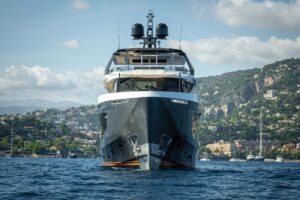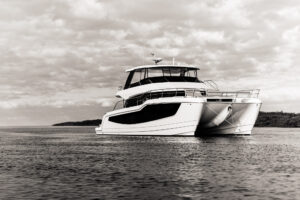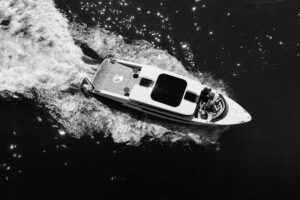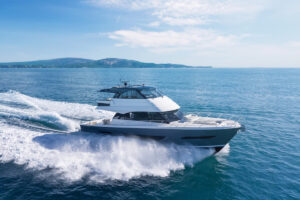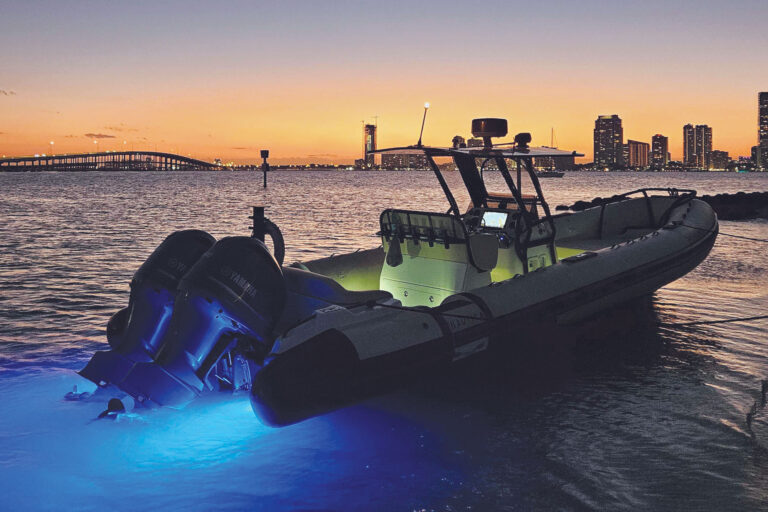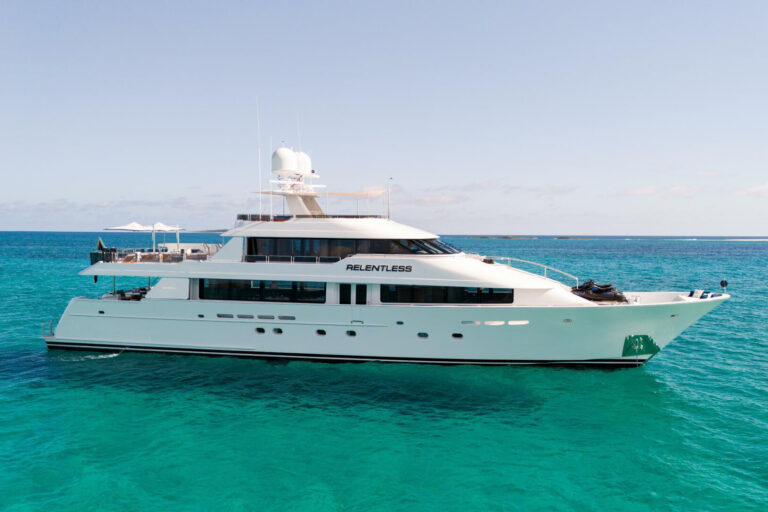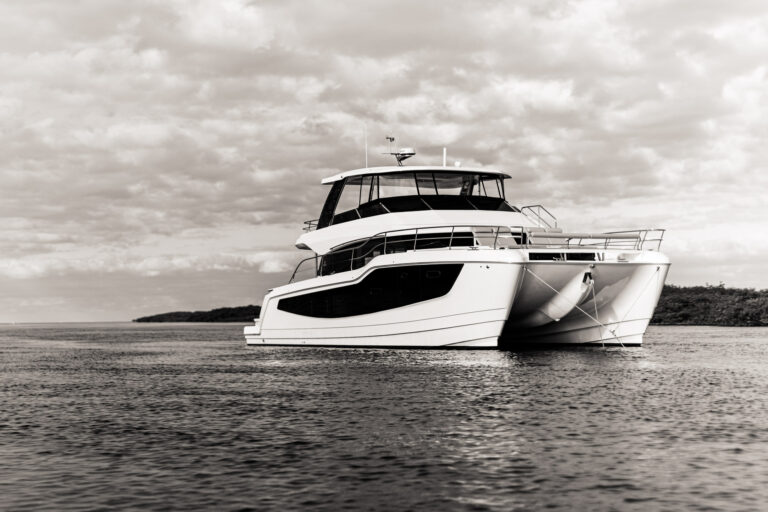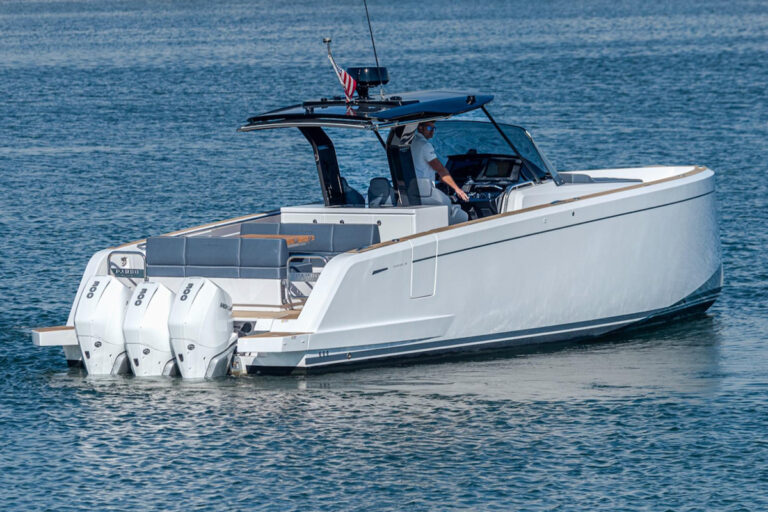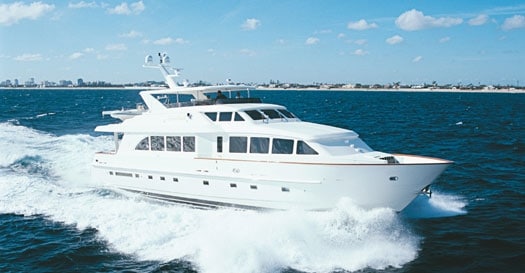
Hargrave 90
Clayton and Michelle McWhorter were no novices when they first started thinking about Hargrave Custom Yachts. His first large motor-yacht was a 61-foot fiberglass design; an aluminum 90-footer followed, then a 74-foot fiberglass motoryacht. By the time something else was needed, they’d toured the horizon of boatbuilders. Like many Hargrave clients, the McWhorters were first moved by the company’s approach to design: traditional raised pilothouse fare softened by modern influence and the flexibility of molded fiberglass. It’s a work in a lineage that founder and namesake Jack Hargrave would certainly have approved of.
The Hargrave brand has been in the capable hands of Michael Joyce since 1998. Under Joyce’s stewardship the emphasis has been on extreme customer care. His team of sales people, designers and service personnel treat their customers as though they were family-which leads to the other thing about Hargrave that intrigued the McWhorters: the company’s cult-like following of loyal customers. Owners love Hargrave.
At this point McWhorter’s broker, David Gennett, suggested they look at a Hargrave. “We met Mike Joyce at the Miami boat show and were impressed with his product and his attitude,” says McWhorter. “A year and a half later we signed the contract.”
McWhorter and his captain Mitch Armstrong worked with Hargrave Custom Yachts’ design team to develop Lady Michelle’s specification. While contract specifications for custom and semi-custom yacht projects come in many shapes and sizes, Joyce has developed a format that he feels his customers understand and appreciate. The core of the specification is fixed around the known items such as structure, machinery, systems and popular equipment. Add to this a generous interior allowance for soft goods, fixtures and interior hardware, and what is left is a list of choices that affords an owner what Joyce refers to as a line-item veto. The result is a detailed specification and accurate pricing.
“I believe I had looked at every builder in the market before we decided to go with Hargrave,” recalls Clayton McWhorter. “These people are real, they deliver what they promise.” Coming from an experienced yachtsman, the praise has added weight.
The microdetailed design approach makes sense considering that Hargrave Custom Yachts’ projects are client driven. “By the time we were done I told Mike (Joyce) that we should change her name from Lady Michelle to Lady Upgrade,” jokes McWhorter. Pretty much anything goes, but there is a point of diminishing returns, and at Hargrave it is well marked. “We design custom yachts until the point we tell the yard to start building,” says Joyce, “and from then on it’s a production-built boat-there are no change orders.” Adds Joyce: “It’s the only way we can maintain our cost advantage.”
A Hargrave Custom Yachts interior package includes the services of the design firm Yacht Interiors by Shelley. “Because of our experience with other boats we had a good idea of what we wanted,” says Michelle McWhorter, who worked with Shelley to develop Lady Michelle’s design. “We are casual people and enjoy our time aboard-we wanted a comfortable, elegant design.” American Cherry was chosen for its even grain and balanced tone. Accent borders and inlaid medallions of beautifully crafted Maitore are featured, along with the high-gloss finish. Silk fabrics, stone surfaces and pewter fixtures and hardware carry out the theme in an interior that is, in my opinion, one of the best examples of the builder’s efforts to date.
“Our 74-footer was a mistake, she was a nice boat but she just didn’t have enough space,” says Michelle McWhorter. Lady Michelle does. Her main deck is arranged with an open full-beam saloon and a formal dining area aft of the raised pilothouse. Sofa-style seating was chosen for its comfort. “We have found that built-in saloon seating is too confining and too often uncomfortable.” A galley and casual dining area are forward of the raised pilothouse, a day head positioned amidships.
Belowdecks, owner and guest accommodations are forward of the machinery space and accessible from the saloon. A master stateroom has his/hers heads that share a walk-in shower, while a guest stateroom to starboard has a queen-size berth with a private head. A guest stateroom to port has two single berths, a Pullman-style berth and a private head. Crew accommodations for three are forward, accessible from the galley area. They include a lounge and two cabins that share a head. A lazarette is accessible from the swim platform or from the afterdeck via the machinery space. There are a washer/dryer, a freezer and a head with a shower.
Exterior public areas include a large afterdeck with a built-in lounge with a table and chairs. A wet bar is fitted with a refrigerator and an icemaker. Stairs lead above to a boat deck that accommodates a 15-foot tender. The bridge is steps away from the pilothouse and has a full control station and a lounge area with a wet bar and grill. A fiberglass hardtop covers the bridge area while a boat-deck sunning area is immediately aft. In all, this is a straightforward, proven American interior and exterior arrangement that makes sense.
Lady Michelle is Hargrave Custom Yachts’ first 90-foot raised pilothouse design and one of a number of offerings that is based on a proven 20-foot beam series hull that the builder uses for yachts from 76 to 99 feet. Her hull form has a moderate entry that transitions into an efficient 13-degree deadrise at the transom. A relatively deep keel improves directional stability and provides some protection to the propellers. Joyce describes his company’s approach to design as “platform engineering.” Instead of starting with a blank piece of paper, the Hargrave Yachts design team draws on the data and experience the firm has collected over the years, always attempting to build on proven solutions.
Given this, Lady Michelle’s construction follows a conservative path. Her hull and superstructure are laminated by hand in female tooling with a combination of stitched and woven reinforcements. A skin coat of vinylester resin is used below the waterline to reduce the chance of blistering. Her bottom is a solid fiberglass laminate and her hullsides, exterior decks and superstructure are cored with Divinycell that is vacuum bagged in place. Her construction follows DNV guidelines (Hargrave Custom Yachts offers full classification for an additional charge). Systems design is in accordance with the recommendations of the ABYC (American Boat & Yacht Council).
Hargrave Custom Yachts has a long-standing relationship with Caterpillar and a variety of Cat-engine options are offered on the 90-Lady Michelle is powered with a pair of the 1,400 hp 3412Es. Hargrave Yachts’ data suggest a cruising speed of 18 knots and a maximum speed of 21 knots at half load. Lady Michelle is based in Palm Beach and will cruise Florida, the East Coast and the Bahamas.
When I first spotted Lady Michelle she was nestled together with a fleet of other Hargrave Custom Yachts at an exhibition of the builder’s recent efforts. While she was not the largest yacht present, she was to my eye the most pleasing.
During his 38-year career namesake Jack Hargrave’s work helped define American yacht design. Hargrave Custom Yachts’ new 90-foot Raised Pilothouse is a reminder of this contribution and I would be willing to bet that her appeal will outlive trend-driven designs that put less stock in tradition. “European styling is not for us,” says Clayton McWhorter. “When I am off the boat for a bit and come back to her, I think, Gosh, what a beautiful boat.” Spoken like a true member of the Hargrave family.
Contact: Hargrave Custom Yachts, (954) 463-0555; www.hargrave.org.

